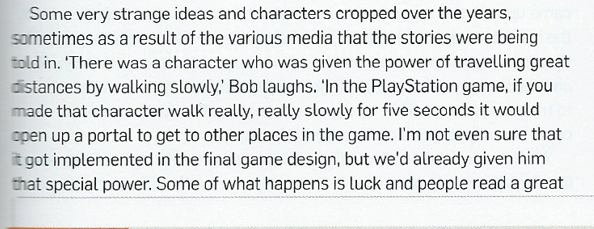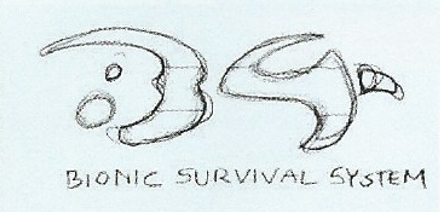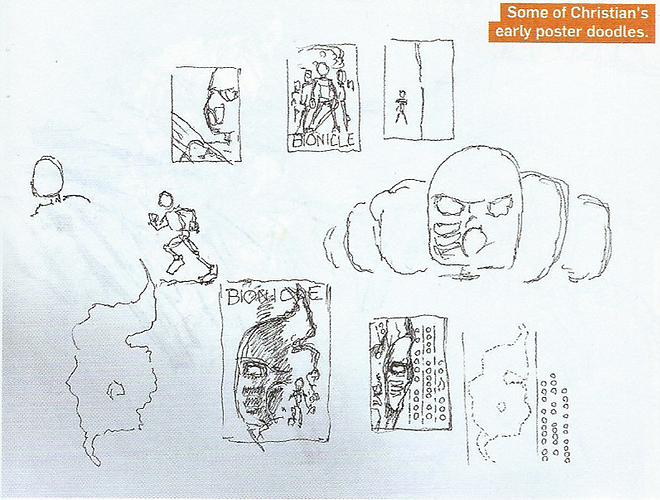A reply on one of my other topics spurred me to buy this magazine to see for myself what it talked about. What I found was a fascinating insight into the unseen history of Bionicle line, which prompted me to make this review.
When I first opened the package containing the Issue #85 of the Blocks magazine, I expected very little. I figured it would contain a few pages of general information regarding the inception and development of Bionicle brand - the typical stuff we already know and almost every youtube video made on the topic regurgitates without adding anything to the discussion. The issue description promised never before seen concept art from Bionicle’s development, but I was VERY skeptical of its novelty - we do have a large depository of Bionicle concept art, mostly thanks to Chris Faber. I fully expected all of the art pieces to be those we have seen already, but I kept the tiniest spark of hope that at least one new picture would be present.
I am glad to say I was mistaken on both of my predictions. The issue contains loads of information, not documented in any other form. Also, while most of the concept art is indeed stuff we already know, there were a whopping four (4!) pieces, which are brand new to the public.
But let’s backtrack a little bit and go from the start…
The cover is dedicated to the Bionicle article - it shows a re-creation of the iconic line up of the original Toa using the 2001 sets. The effects of the eye glow may be jarring to the long time fans, making the Toa look somewhat evil, but that is just a minor detail.
Ok, so let’s get the annoying negatives out of the way first, so that they won’t bother us going forward. Most obviously of all, the major mistake persistent throughout the issue is the swapping of Gali Mata for Gali Nuva. She is the only Toa swapped out for a later iteration and it breaks the line up apart. The article itself contains the pictures of the original Toa sets and Gali Nuva is once again present with the set number 8533 - a set number belonging to Gali Mata. They clearly mistook the two sets, which is unfortunate, but at least it’s still Gali and not Nokama. The cover also contains a big mask with glowing (again evil-like) eyes. The choice of the mask is very confusing however, being Gali’s mask. Of course because of the Gali mistake, the mask is Kaukau Nuva. I am not sure what they were going for with this, as even the correct regular Kaukau wouldn’t really make sense. I suspect a big background mask with evil eyes was supposed to represent Makuta (just like the infected Hau of 2001), but the final execution is just bizzare. One positive comming out of this choice is that this is probably the most prominence a Kaukau Nuva has ever enjoyed ![]()
Starting from here, there are really no negatives, only positives.
The article celebrating 20 years of Bionicle is the longest one in the magazine and covers 11 pages!
The first page gives an abbreviated rundown of the story and discusses the innovative and experimental nature of the technic based action figures, as well as its emphasis on storytelling. It also introduces Faber and sets the financial struggle environment of the 90s.
At this point I should mention that the article is comprised of interviews of several people heavily involved in Bionicle: Chris Faber, Alastair Swinnerton and Bob Thomson.
The first section talks about Bionicle’s predecessors. The Cybots (an idea of Faber) was at one point considered to be like a model kit with pieces meant to be painted by the buyer.
While the Cybots concept did not take off, it influenced the later product - Slizer. The Slizer (Throwbot) product line was apperently a very successfull hit fullfilling the goal of making a ‘craze product’, which LEGO aimed for. Roboriders that succeeded Slizer was considered a step back and was not as popular.
The next section turns to the inception of Bionicle itself. Bob Thomson was hired at the sunset of the Bone Heads of Voodoo Island stage of the project.
“People that have come from product design, they’re taught that people have to pick products up and understand them immediately. But if you pick it up and understand it immediately, there’s no depth, it’s an instant throwaway experience. If you pick it up and then you have to discover more and more and more and more about it then you start to imbue that character with personality. You start to understand who they are.”
This is a very good suggestion that Thomson put forward.
The article then switches to Swinnerton saying that out of all the ideas for a backstory of the prototype toys, Bone Heads of Voodoo Island brief was the longest one, detailed on three and a half pages as opposed to single page alternatives. It was this complexity and richness that made him choose this particular concept and expand upon it. Developing a pitch for a story bible, Swinnerton came up with exotic names for the Toa, replacing the prototype terms like ‘Hook’ or ‘Claw’.
After an inspiring description of how the creative team got together, the topic switches to Faber’s diagnosis and how he projected himself into the story as a sick creature under the island.
Following section elaborates on this story engine. It is made clear here that the giant robot was never meant to be a set and instead drove the story forward from the shadows, like a myth. The characters, being maintenance workers on a planet-sized robot were unaware of their purpose and had all of the legends and myths as a pseudo-religion.
The early concept of Makuta is also discussed by Bob Thomson:
“Even the villains were not intended to be symbols of pure evil. ‘All the best bad guys have a purpose,’ says Bob. 'Makuta had a very definite purpose. He was a guy with difficult decisions to make. He’s prepared to do whatever it takes to stop these Toa waking up Mata Nui. As soon as we had the conflict, you can have limitless drama because you’ve got two factions that have completely opposing ideologies.”
Faber remarks that in the initial concept, they had a structure sufficient to run the theme for at least five to six years, but a hopefull goal was three years.
Here comes a very important point I wish more people heard. Hardcore fans often get too caught up in arguing about ‘which source is more canon’. But the truth is that Bionicle was always meant to be what it has become: a multi-media experience where you have to consume every last bit if you want to have a trully complete picture.
“‘You create a story bible, where you plot out the character arcs and the essential things that you need to get from the beginning to the end of each story season. We were working on a Bionicle multi-platform experience’. By the end of its original run, there had been around seventy books, more than fifty comics and graphic novels, seven video games, four films and plenty more besides. ‘You’ve 20 odd places to tell the story but you’ve also got 12 principal characters,’ says Bob. " ‘Probably another 18 characters each year to service. Just writing backstories for them was a fairly major undertaking.’”
The same page contains the paragraph I originally wanted the magazine for. I discuss it in a different topic, but there is one thing that catches your eye:

The final sentence is cut off! You would expect it to continue on the next column on the page, but nope. It probably ended up covered by the picture below it during the editing process. I was looking for it everywhere, but it is just not visible. And it was so important! Now, there is one more piece of lost media in the world of Bionicle - this was and still is, as of me writing this, one of the last sentences spoken by Bob Thomson about Bionicle. Oh the irony of fate… will we ever find out the truth behind this mystery? ![]()
Section about toy design on the next page talks mainly about challenges of expressing the biomechanical nature of the characters.
Remaining topics on the page are Maori language controvery (nothing you don’t know about) and an interesting fact about the marketing. The reason why there were two types of commercials (set commercials and story ads made in CG) is that the ads showing toys were not allowed to show the sets doing things they cannot really do (bending knees etc.), so this was reserved for CG commercials.
The following section starts on this page but continues onto another. This has to be the most important and fascinating part of this article and it is not an understatement to say that the revelations are huge! So much of the story makes SO much more sense when you know the information contained in these pages.
Faber describes how he recieved a script for a Bionicle movie proposition on friday and he didn’t like it at all. Based on other sources, this was possibly a 4th Bionicle movie. In this script, big armies were fighting each other like Lord of the Rings, and the result was a movie that was way too dark for what Bionicle was meant to be at the time. Faber wondered how best to react to this script and course correct the direction of the story. He and his collegues had to respond by monday, so they only had a single weekend to think up the future story of Bionicle. It was during this weekend that the entire Ignition trilogy was concieved.
We learn that it was originally the Toa Nuva that were meant to be the main heroes of this story arc and it was supposed to be the fullfilling of their destiny. The Mask of Life’s original purpose was to wake up Mata Nui and reboot the universe rather than save his life.
The next revelation is even bigger. It is the reason behind it even being a trilogy in the first place:
“If you can find this mask, then you can restart Mata Nui. It’s really a difficult task to get it. When you get it, you lose it again, then it’s even more difficult to get it. And when you get it the third time, you have to actually sacrifice your life to light this big robot up. That whole thing was thought out in a few hours on a sunday in desperation over the script that was actually on the table.”
This is monumental and sheds light on so much stuff about the 2006, 2007 and 2008. For whatever reason, no one ever questioned the trilogy, but now we know why it was there in the first place. You need to find the mask three times and it gets progressively harder - thus three story years for each event. It also rhymes with the fact that the Ignika has the three stages of its doomsday function: gold, silver black. It really does rhyme like poetry and funnily enough, the trilogy did have a poem for it.
Of course, this original intent was not carried out as planned and things were moved around a bit. Toa Nuva set out on a journey to save great spirit’s life instead of waking him up, but they failed. Toa Inika then pick up and get the mask on Voya Nui. Then true to its core concept, the mask escapes their grasp and hides under the waves of the ocean. Toa Inika now Toa Mahri follow it down there to fulfill this destiny. They find it for the second time, but manage to use it before it escapes them again (as it should have) paying the price of Matoro. It is then it gets lost for the third time and it is the Toa Nuva who find it coming full circle. They do actually use it to wake up Mata Nui as originally intended, though this is not the masks purpose in the updated lore, merely a shortcut.
The article does not state which of the Toa Nuva would have been the sacrifice had the original version of the trilogy taken place. The magazine was worth it just for this section alone and it really changed how I view the trilogy.
Interesting detail about the film making process included here, is that they specifically designed the movies to be inaccessible to adults. It was just for the fans. They also made a concerted effort to not dumb down, but to smart up the story.
Fun fact: the idea of the seventh Toa came from Swinnerton and during the movie premiere, he fell asleep on the shoulder of the head of Miramax ![]()
The article closes off reiterating how the whole thing was a team collaboration - it seems the virtue of unity is trully important ![]()
…
So that was the article! I am very glad I bought this magazine, it was very eye opening, and that’s saying something because there is so much we already DO know, it becomes harder and harder to find things you didn’t know about Bionicle.
There is one more thing I need to talk about and that is the concept art. In total and excluding the cover, there are 29 pictures in the article, and 4 of them are new. I am now going to discuss them in the order of excitement.
The first and least exciting art piece is a variation of one we have seen previously - the B4 logo. This time it is in higher quality and with the extra word ‘system’:

The second is the concept art for Bionicle posters. You can clearly see the design beats that eventually made it into the final product, such as the Toa line up, Hau/island split, or the key visual:
Now we are getting into some really exciting stuff! There are some early Toa sketches, but the word early might be misleading in this case. They clearly have the final design, and judging from their action poses, I suspect these are sketches for the Advance CG renders, animations and box art of the Toa!
I have saved the best for the last. We have several concept art pieces of the Great Spirit robot, but it looks like there are still plenty more out there. This one shows the entire body from front and side view. Interestingly, you can also see that (as with some other sketches) it consists of multiple layers of paper superimposed on each other. The bottom layer has some rocks and clouds on it but there are also these three strange kaleidoscopic shapes whose identity is a mystery. I don’t think we can find out what these were meant to represent (unless Faber remembers) - a wild guess flashed through my mind of concept for Red Star given its position above clouds, but I doubt it to be honest, so don’t quote me on it.
I would like to contact Biomedia project so that these can be archived. It would also be great to have the entire article archived there among the other magazines, but I am not sure if it would cause some copyright issues (seeing as Blocks magazine is still very much active). Maybe someone can tell me their suggestions.
That will be all, thank you for reading!



